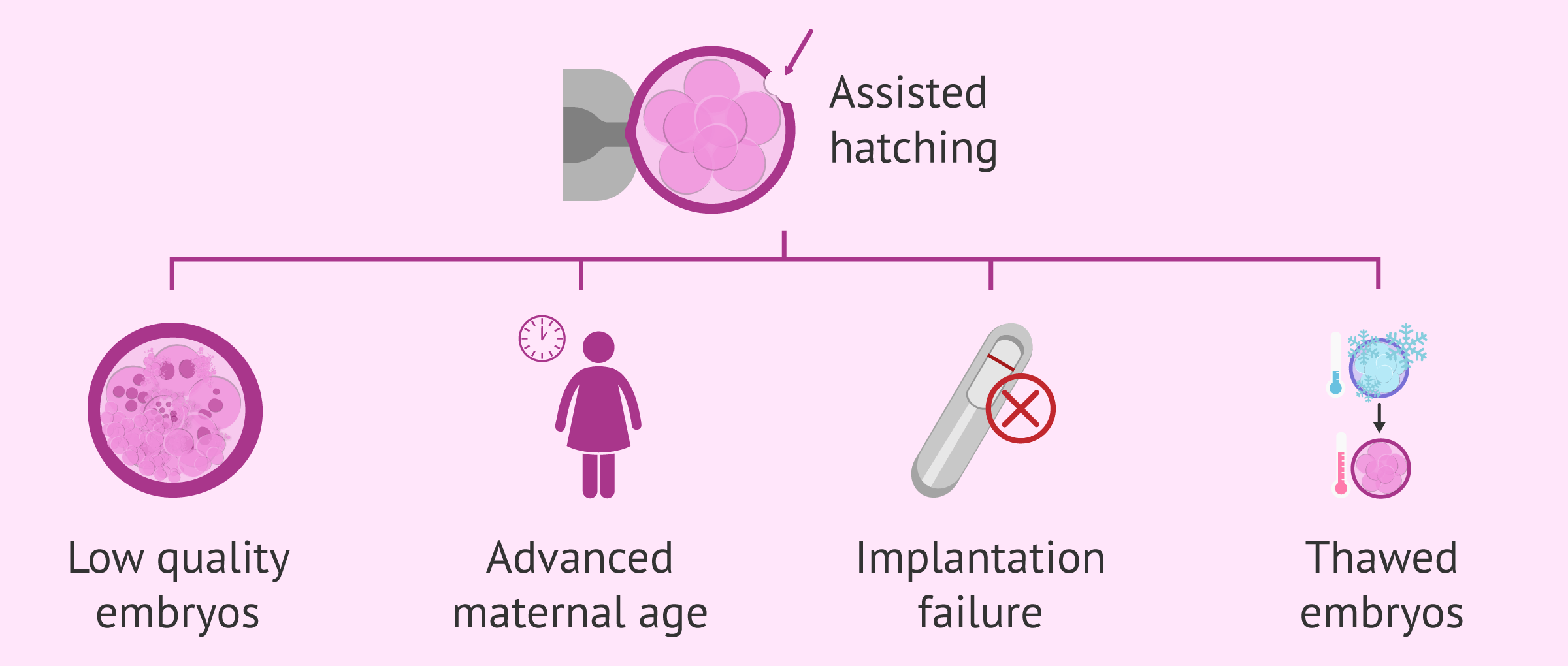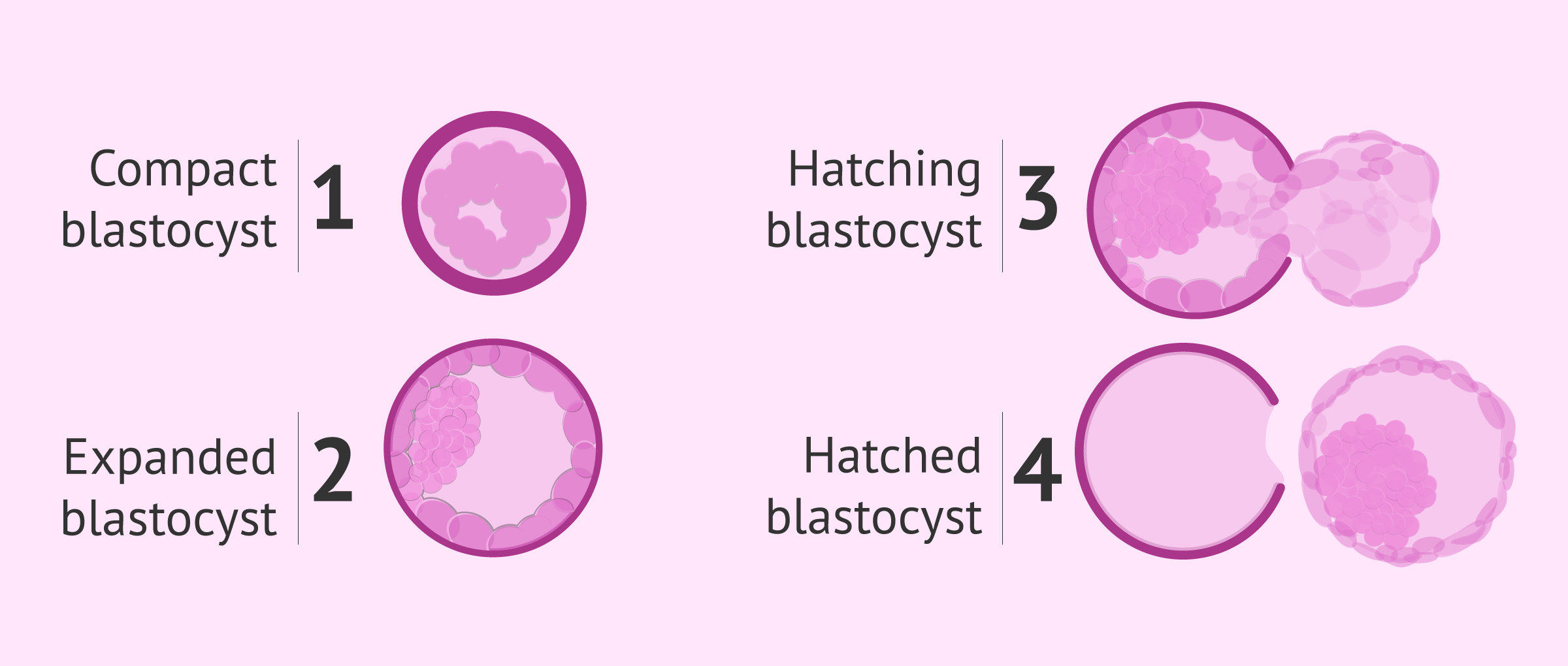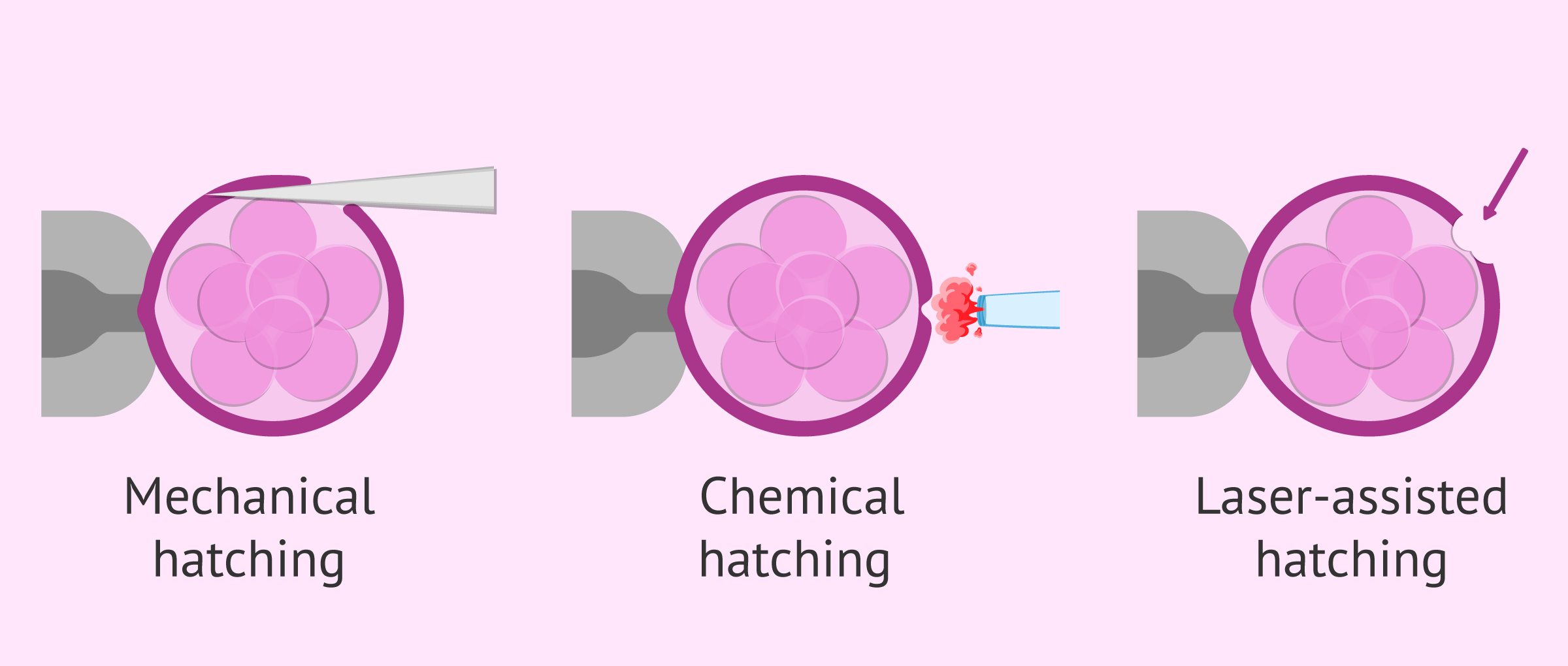Assisted hatching is a complementary technique that can be done to embryos in culture during an in vitro fertilization (IVF) treatment.
It consists of making a small hole in the zona pellucida of the embryo in order to facilitate the exit of the expanded blastocyst, a phenomenon known as hatching, and thus improve implantation rates. This procedure can be carried out mechanically, chemically and with the use of a laser.
Assisted hatching is not routinely used in assisted reproduction laboratories, but is indicated in some cases of embryos frozen prior to transfer.
Provided below is an index with the 7 points we are going to expand on in this article.
- 1.
- 2.
- 2.1.
- 2.2.
- 3.
- 4.
- 4.1.
- 4.2.
- 4.3.
- 4.4.
- 4.5.
- 4.6.
- 4.7.
- 5.
- 6.
- 7.
What is hatching?
The hatching of the embryo is a natural process that takes place around the 6th day of embryonic development, by which the embryo in the blastocyst stage is freed from the protein layer that surrounds it, called the zona pellucida, and comes out.
The zona pellucida is the external membrane of the embryo that protects it until it finally manages to hatch and implant itself in the uterus.
Fertilized eggs have a zona pellucida of about 0.015-0.020 mm thick in their first days of development since at this stage the embryo multiplies its cells but does not increase in size.
As embryonic growth and volume progress, this outer protein layer thins until it breaks down because the cell content no longer fits inside it.
Depending on whether or not hatching has already taken place, there are 3 types of blastocysts:
- Expanded blastocyst
- the embryo is large and the zona pellucida is thinner.
- Hatching blastocyst
- the zona pellucida has been broken and the embryo is coming out.
- Hatching or hatched blastocyst
- the embryo has already completely detached itself from the zona pellucida.
You can read more about this in the following article: What is IVF blastocyst culture? Success rates and timeline.
Assisted hatching
Sometimes, some embryos have a thickened or deformed zona pellucida that makes it difficult to leave and, therefore, can lead to implantation failure.
To solve this problem, assisted reproduction relies on the technique of assisted hatching: making a hole in the outer layer of the embryo and facilitating its exit.
In the following section, we are going to comment on several details about this assisted hatching.
Indications
Assisted hatching is not routinely done in all laboratories. It is only indicated in specific cases such as the following:
- Fertilized eggs with a thickened zona pellucida.
- Transfer of thawed embryos, since vitrification produces a hardening of the zona pellucida.
- Women over 37 who have trouble getting pregnant.
- High serum basal FSH values.
- Repeated failures after several IVF cycles.
- Slowly developing embryos. For example, when on day 3 they have less than 6 cells.
- Embryos with an abnormal or darkly colored zona pellucida.
- Embryos with high percentage of fragmentation. When the hole is made in the zona pellucida, it is used to suck out the fragments.
It should be noted that those embryos biopsied for PGD will already have made the hole and, therefore, will easily hatch once they reach the stage of expanded blastocysts.
How is it carried out?
Normally, assisted hatching is performed on the third day of development, when the embryo usually has about 8 cells and its size has not yet increased.
As for how to do it, there are 3 possible techniques:
- Mechanical Hatching
- a needle is passed through the zona pellucida and drilled through it by friction against a pipette. It is a technique that is rarely used because of the risk of harming the embryo.
- Chemical hatching
- an acidic solution, such as Tyrodes acid, is used to degrade the pellucid zone to a hole.
- Laser Hatching
- is the most widely used method today because of its greater control and safety when making the hole since only a few micro-pulses of a laser are required. However, it has the disadvantage of being the most expensive technique.
However, today, the method most commonly used by most fertility centers for assisted embryo hatching is the laser because of the safety it offers.
Results
Assisted hatching is only an advantage for the cases we have discussed in the previous section. For this reason, it is not offered to all patients who are going to undergo in vitro fertilization.
In cases of repeated implantation failures or poor quality oocytes per thickened zona pellucida, assisted hatching does increase the possibility of pregnancy. Making it easier for these embryos to detach from their zona pellucida can help them adhere to the endometrium and implant.
On the other hand, the results obtained in different clinics that perform this technique are highly variable and, therefore, it is difficult to draw a conclusion.
What is clear is that, if this technique is not used for the cases indicated, its application does not provide any advantage in achieving pregnancy.
IVF with frozen embryos, as any other reproductive technology, requires that you rely on the professionalism of the doctors and staff of the clinic you choose. Obviously, each clinic is different. Our Fertility Report selects several clinics for you out of the pool of clinics that meet our strict quality criteria. Moreover, it will offer you a comparison between the fees and conditions each clinic offers in order for you to make a well informed choice.
FAQs from users
In which cases is assisted hatching recommended?
Assisted hatching is usually used as a complementary technique since in some cases it can help the implantation of the embryo. It involves making a small hole in the pellucid layer that covers the embryo (the area that protects the embryo) to promote hatching (the embryo leaving its membrane) for subsequent implantation.
It is usually recommended for patients who have obtained poor quality embryos in previous treatments, in elderly patients (whose oocytes have a thicker or more hardened membrane) and in implantation failures. It is of great help to use it in the transfer of embryos that have already been cryopreserved.

It should only be used in the cases described above, in the rest of the clinical situations it is not advisable because it does not imply any confirmed benefit.
What methods are used in assisted hatching?
Assisted hatching consists of opening a hole in the embryo, specifically in the zona pellucida. In this way, the embryo is helped to break the zona pellucida, facilitating its implantation.
The external layer that surrounds the oocyte is the zona pellucida. The sperm crosses this layer when fertilization takes place and persists during the first days of development. With the passage of hours, this zone becomes thinner until it is finally broken by the embryo and in this way it can adhere to the endometrium.
The hole can be made mechanically (laser), chemically, through the use of Tyrodes acid.

Medical studies show that there is no evidence that implantation or live birth rates are improved with the use of Assisted Hatching, so the use of this technique is generally not recommended in infertile patients.
What is Assisted Hatching?
Assisted Hatching (AH) is an assisted reproduction technique that can be used in the IVF lab with the resulting embryos. AH involves the penetration of the zona pellucida that recovers the embryos using a laser. It is performed on day 3 of embryo development.
AH allows the blastocyst to leave the zona pellucida, thereby increasing the implantation potential of embryos. Given that it is an invasive technique that carries some risks, it is indicated in the following cases only: patients who are 37 or over, embryos with a thick, dark or abnormal zona pellucida, multinuclear embryos, previous implantation failure, developmentally delayed cleavage-stage embryos, too high FSH levels, poor responders.
What is assisted hatching in IVF with ICSI?
Assisted Hatching (AH) is a state-of-the-art technique that is used both in conventional IVF an ICSI procedures. It involves the artificial disruption of the ZP (zona pellucida) after the egg is fertilized in the laboratory.
AH is performed after IVF and ICSI procedures, right before the embryo transfer. The embryologist creates a small hole in the ZP by means of micromanipulation under a microscope. By doing this, we make it easier for the embryo to hatch out of the zona pellucida and implant to the uterine lining.
According to the ASRM (American Society for Reproductive Medicine), it is used in cases of women with advanced maternal age, poor embryo quality or after the failure of two or more previous IVF cycles.
Is it recommended to do assisted hatching on frozen embryos?
The transfer of frozen embryos is one of the indications for assisted hatching, as the vitrification process may have hardened the zona pellucida of the embryos. However, this technique is not usually used routinely and, in addition, the pregnancy rate of vitrified embryos is similar to that of fresh embryos.
Read more here: Frozen embryo transfer.
Is assisted hatching recommended for the aspiration of fragments?
Yes, this is one of the indications for assisted hatching, since there are studies that indicate that the cell fragments prevent the evolution of the embryo. In addition, this technique has the interesting name of embryo make-up, since it consists of aspirating the fragments through the hole made to leave the embryo clean and as beautiful as possible.
Does assisted hatching improve embryo implantation?
Yes, assisted hatching is a complementary technique used in the field of assisted reproduction. It involves making a small hole in the zona pellucida of the embryo, which facilitates its expansion and, therefore, implantation in the maternal uterus.
However, assisted hatching prior to embryo transfer should only be carried out in those cases especially recommended by specialists.
Suggested for you
As we have mentioned, assisted hatching is a complementary technique to in vitro fertilization. If you want to learn more about the process, you can access the following post: What is in vitro Fertilization?
On the other hand, implantation failures are one of the main indications for assisted hatching. We recommend you read the following post for more information: Repeated embryo implantation failure- reasons why embryos don't implant.
We make a great effort to provide you with the highest quality information.
🙏 Please share this article if you liked it. 💜💜 You help us continue!
References
Da Li, Da-Lei Yang , Jing An, Jiao Jiao, Yi-Ming Zhou, Qi-Jun Wu, Xiu-Xia Wang. Effect of assisted hatching on pregnancy outcomes: a systematic review and meta-analysis of randomized controlled trials. Sci Rep. 2016 Aug 9;6:31228. doi: 10.1038/srep31228 (View)
Eid Hammadeh M, Fischer-Hammadeh C, Refaat Ali K. Assisted hatching in assisted reproduction: a state of the art. J Assist Reprod Genet. 2011 Feb;28(2):119-28. doi: 10.1007/s10815-010-9495-3. Epub 2010 Nov 2 (View)
Elnahas M, Elnahas T, Azmy O, Elnoury A, Abdelhalim A, Aboelghar M, Alhassani S, Noureldin R. The use of laser assisted hatching of frozen/thawed embryos versus laser assisted hatching of fresh embryos in human intracytoplasmic sperm injection. J Obstet Gynaecol. 2018 Jul;38(5):729. doi: 10.1080/01443615.2018.1444392 (View)
He F, Zhang C, Wang L, Li S, Hu L. Assisted Hatching in Couples with Advanced Maternal Age: A Systematic Review and Meta-analysis. Curr Med Sci. 2018 Jun;38(3):552-557. doi: 10.1007/s11596-018-1913-2 (View)
Hernández-Nieto CA, Soto-Cossio L, Basurto-Díaz D. Assisted hatching for improving embryo implantation. A bibliographical review. Ginecol Obstet Mex. 2015 Apr;83(4):232-9.
Uppangala S, D'Souza F, Pudakalakatti S, S Atreya H, Raval K, Kalthur G, Kumar Adiga S. Laser assisted zona hatching does not lead to immediate impairment in human embryo quality and metabolism. Syst Biol Reprod Med. 2016 Dec;62(6):396-403. doi: 10.1080/19396368.2016.1217952. Epub 2016 Sep 6 (View)
Zeng M, Su S, Li L. The effect of laser-assisted hatching on pregnancy outcomes of cryopreserved-thawed embryo transfer: a meta-analysis of randomized controlled trials. Lasers Med Sci. 2018 Apr;33(3):655-666. doi: 10.1007/s10103-017-2372-x. Epub 2017 Nov 7 (View)
FAQs from users: 'In which cases is assisted hatching recommended?', 'What methods are used in assisted hatching?', 'What is Assisted Hatching?', 'What is assisted hatching in IVF with ICSI?', 'Is it recommended to do assisted hatching on frozen embryos?', 'Is assisted hatching recommended for the aspiration of fragments?' and 'Does assisted hatching improve embryo implantation?'.
Authors and contributors










